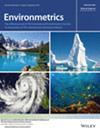A Non-Parametric Estimation Method of the Population Size in Capture-Recapture Experiments With Right Censored Data
IF 1.7
3区 环境科学与生态学
Q4 ENVIRONMENTAL SCIENCES
引用次数: 0
Abstract
We present a new non-parametric approach for estimating the total number of animals or species when we only have information on the number of animals or species that have been observed once, twice, , and the number of animals or species that have been observed and more than times. The approach, like the Chao estimator, gives a lower bound on population size while also providing bootstrap confidence intervals. We conducted simulations to compare our estimator to other competing ones in special scenarios with and 3 and found that it performed quite well. In the case of uncensored samples, we analyze which censoring point is preferable in specific examples, as well as when censoring at is superior to censoring at .
右截尾数据捕获-再捕获实验中种群大小的非参数估计方法
我们提出了一种新的非参数方法,用于估计动物或物种的总数,当我们只掌握了被观察过一次、两次、......$$ \dots $$ 的动物或物种的数量,以及被观察过 r $$ r $$ 和超过 r $$ r $$ 次的动物或物种的数量。这种方法与 Chao 估计法一样,在给出种群数量下限的同时,还提供了引导置信区间。我们进行了模拟,在 r = 2 $$ r=2 $$ 和 3 的特殊情况下,将我们的估计器与其他竞争估计器进行比较,结果发现我们的估计器表现相当出色。在无删减样本的情况下,我们分析了在具体例子中哪个删减点更可取,以及在 r = 3 $$ r=3 $$ 时的删减优于在 r = 2 $$ r=2 $$ 时的删减。
本文章由计算机程序翻译,如有差异,请以英文原文为准。
求助全文
约1分钟内获得全文
求助全文
来源期刊

Environmetrics
环境科学-环境科学
CiteScore
2.90
自引率
17.60%
发文量
67
审稿时长
18-36 weeks
期刊介绍:
Environmetrics, the official journal of The International Environmetrics Society (TIES), an Association of the International Statistical Institute, is devoted to the dissemination of high-quality quantitative research in the environmental sciences.
The journal welcomes pertinent and innovative submissions from quantitative disciplines developing new statistical and mathematical techniques, methods, and theories that solve modern environmental problems. Articles must proffer substantive, new statistical or mathematical advances to answer important scientific questions in the environmental sciences, or must develop novel or enhanced statistical methodology with clear applications to environmental science. New methods should be illustrated with recent environmental data.
 求助内容:
求助内容: 应助结果提醒方式:
应助结果提醒方式:


